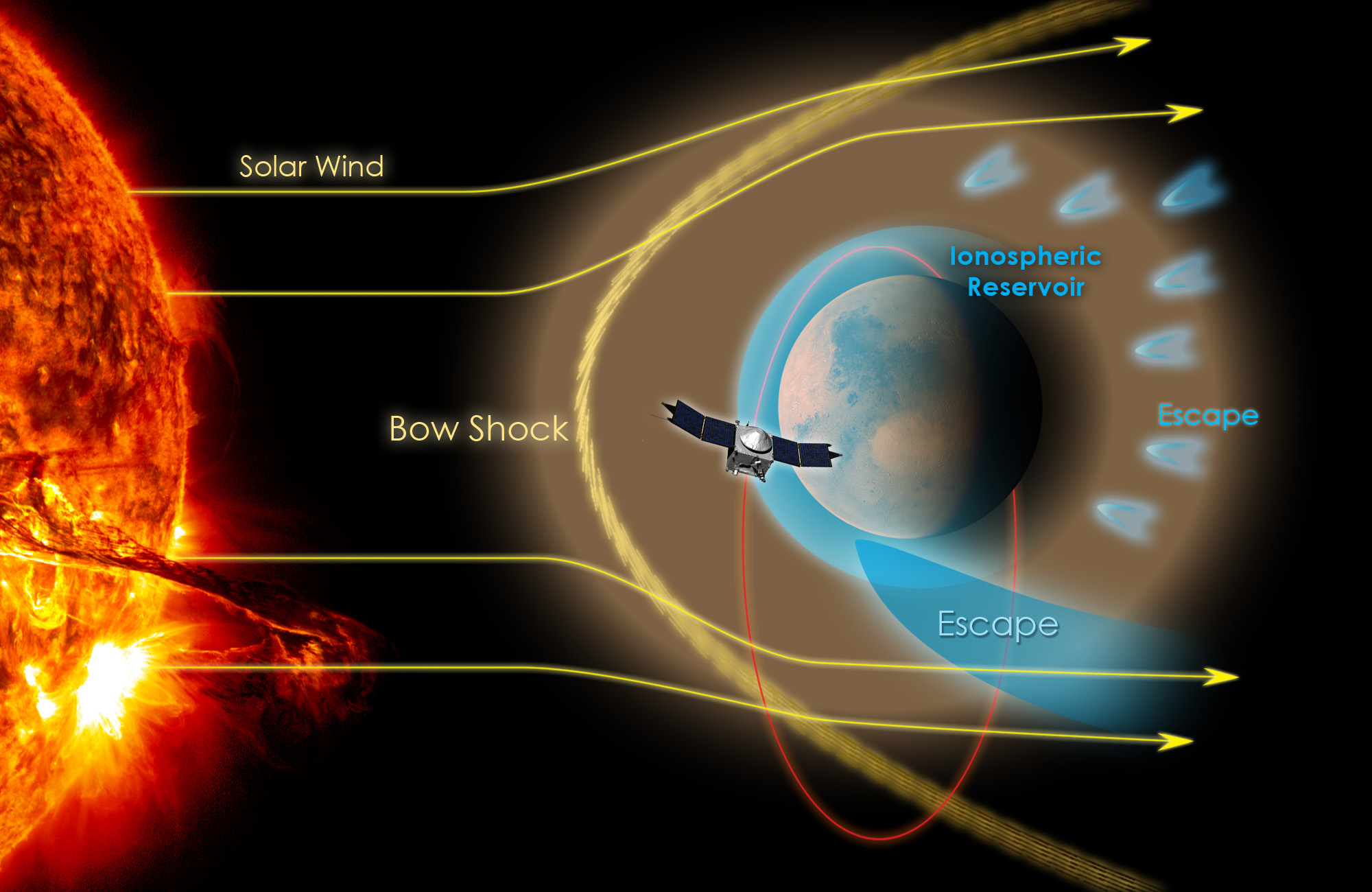
NASA’s newest Mars orbiter, MAVEN, has begun its unprecedented mission to unlock the mysteries of Mars’ climate history and determine why the Red Planet lost most of its atmosphere over the past four billion years.
Top scientists leading NASA’s Mars Atmosphere and Volatile Evolution (MAVEN) mission discussed the early results Monday, Dec. 15, at a briefing held at the annual meeting of the American Geophysical Union (AGU) in San Francisco, Calif.
Initial findings from MAVEN are starting to provide clues on a new process by which the solar wind penetrates the atmosphere and contributes to how Mars lost its atmosphere and ability for liquid water to exist on the surface over time. Liquid water is a prerequisite for the formation and evolution of life as we know it.
The $671-million MAVEN spacecraft’s goal is to study Mars’ tenuous upper atmosphere in detail for the very first time by any spacecraft and to explore the mechanisms of how the planet lost its atmosphere and life-giving water over billions of years, as well as determine the rate of atmospheric loss.
“MAVEN started its primary science mission phase one month ago on Nov. 16,” said Bruce Jakosky, MAVEN principal investigator with the Laboratory for Atmospheric and Space Physics at the University of Colorado, Boulder, at the briefing.
“The goals are to understand the role of the loss of Mars atmosphere, try to understand the energy inputs into the upper atmosphere from the sun and the solar wind, determine the response of the upper atmosphere to that and effects of the energy inputs, and understand the processes that led to the escape of the atmosphere over time.”
“The spacecraft is performing very well so far.”
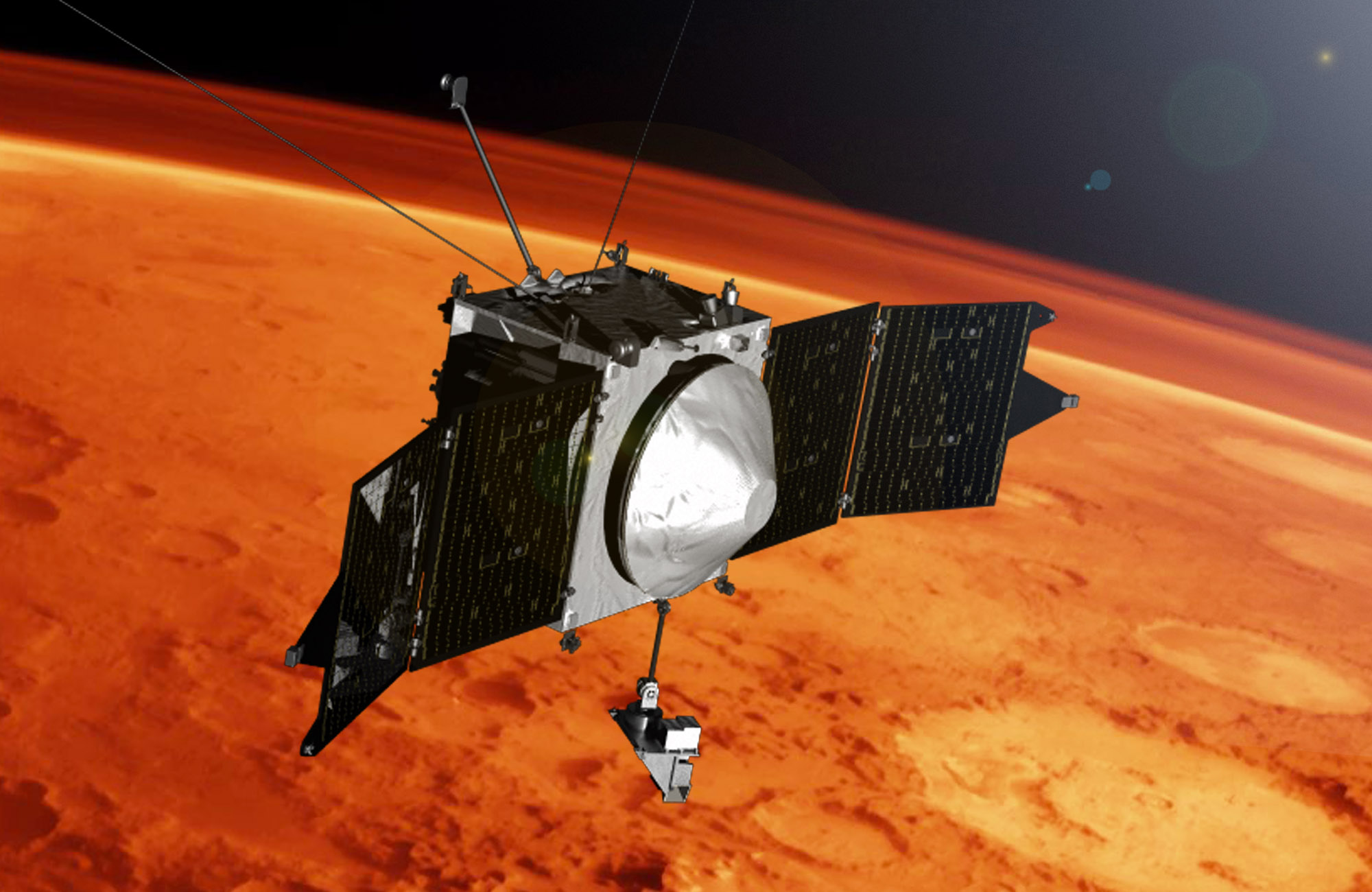
The early science results already bode well for completing the mission’s main research objectives during the primary science phase.
“We are beginning to see the links in a chain that begins with solar-driven processes acting on gas in the upper atmosphere and leads to atmospheric loss,” said Jakosky.
“Over the course of the full mission, we’ll be able to fill in this picture and really understand the processes by which the atmosphere interacts with the solar wind changed over time.”
“Right now we are still early in the mission and starting to piece together some of the links in the chain of loss.”
The probe is now conducting its regular observations of the Martian upper atmosphere, ionosphere, and solar-wind interactions.
The Martian ionosphere is a layer of ions and electrons that spans in altitude from about 75 to 300 miles above the surface, and MAVEN travels through it on each orbit. It acts as a kind of shield around the planet, deflecting the solar wind, an intense stream of hot, high-energy particles from the Sun that partially plays a role in stripping away the planet’s atmosphere.
Recent observations from MAVEN’s Solar Wind Ion Analyzer (SWIA), Neutral Gas and Ion Mass Spectrometer (NGIMS), and Suprathermal and Thermal Ion Composition (STATIC) instruments are already providing a treasure trove of new data barely a month into the science mission.
Researchers explained how the instruments are revealing a new process by which the solar wind can penetrate deep into the Martian atmosphere, the first comprehensive measurements of the composition of Mars’ upper atmosphere and electrically charged ionosphere, and an unprecedented view of ions as they gain the energy at various altitudes that will lead to their eventual escape from the atmosphere.
The SWIA instrument has discovered a stream of solar wind particles that penetrate deep into Mars’ upper atmosphere and ionosphere because they are not deflected by the ionosphere, according to Jasper Halekas, SWIA Instrument Lead, University of Iowa.
“We discovered a new population of ions at low altitudes. The solar wind protons are transformed and pick up a charge to become neutral hydrogen, penetrate what we thought was an impenetrable barrier and dive down to very low altitudes,” said Halelas at the briefing. “Then they interact with the dense ionosphere and become charged again while immersed in the magnetosphere.”
“We can use these ions to remotely monitor the solar wind from deep inside the magnetosphere.”
“MAVEN’s orbit samples all the regions including the reservoirs of particles in the ionosphere and the escaping particles and what is driving the escape. The particles are moving at supersonic speeds.”
The reappearance of these ions, which retain characteristics of the pristine solar wind, provides a new way to track the properties of the solar wind and may make it easier to link drivers of atmospheric loss directly to activity in the upper atmosphere and ionosphere, according to a NASA statement.
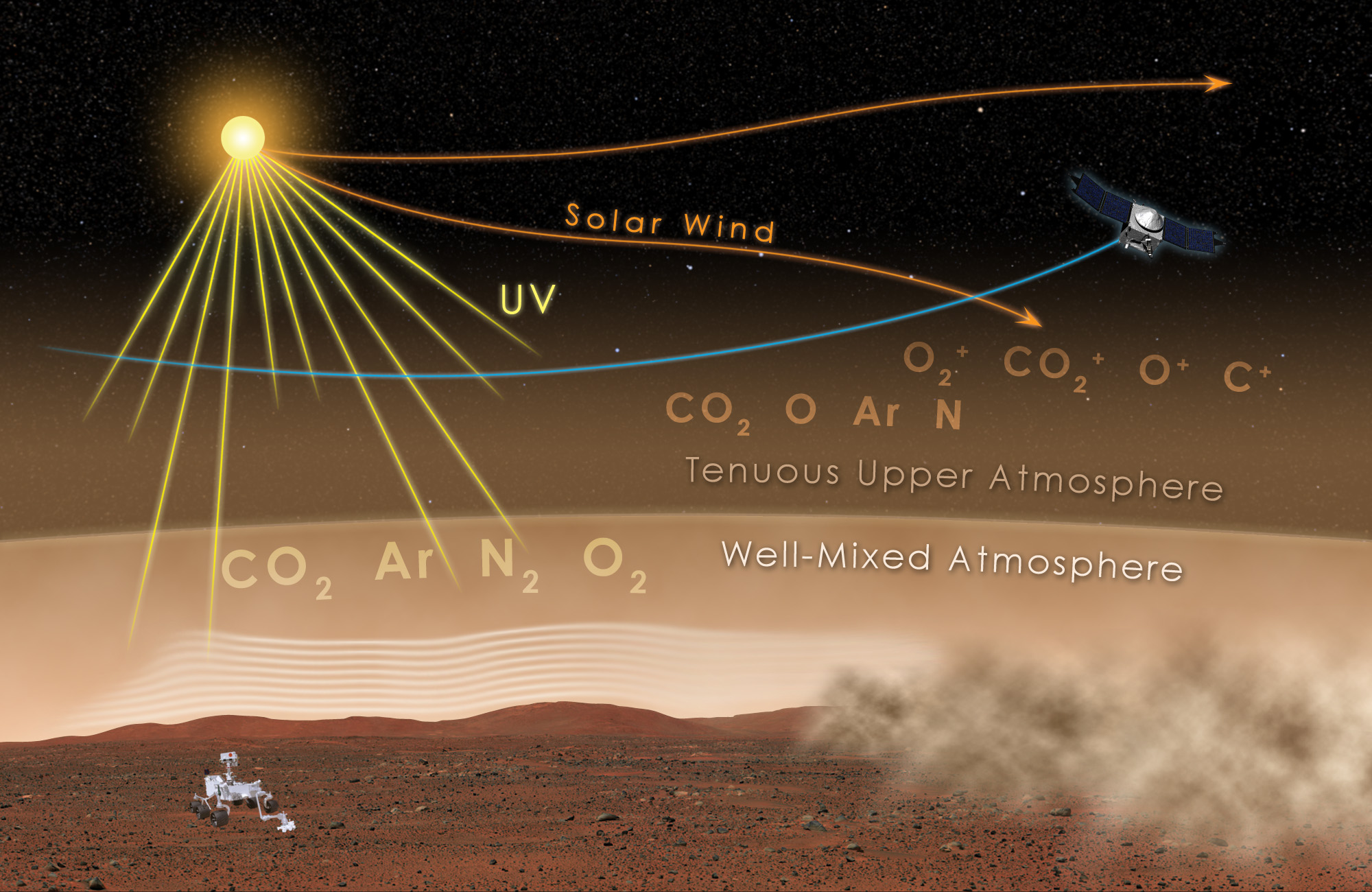
The NGIMS instrument is focused on discerning the identity and composition of the upper atmosphere and ionosphere.
“We are discovering a remarkable structure and variability in a whole suite of atoms and molecules and ions in a region of space being explored in detail for the first time in the upper atmosphere,” said Paul Mahaffy, NGIMS Instrument Lead, NASA’s Goddard Space Flight Center.
These studies connect the interactions between the thin lower atmosphere (mostly comprised of carbon dioxide), which controls climate, and the tenuous upper atmosphere, where the loss is occurring at altitudes from 75 to 300 miles.
“This is important to analyze because the reservoir of constituents shows the history of the atmospheric loss from Mars over billions of years and its ability to sustain life.”
NGIMS is measuring the mass spectral abundances of many gases in ion and neutral forms (see the graphic), revealing well-defined structure in the upper atmosphere and ionosphere, in contrast to the lower atmosphere, where gases are well-mixed.
“The structure is changing from orbit to orbit. There are both atomic species and molecules in the upper atmosphere. The most abundant species are molecular oxygen and atomic oxygen at an altitude above about 200 km.”
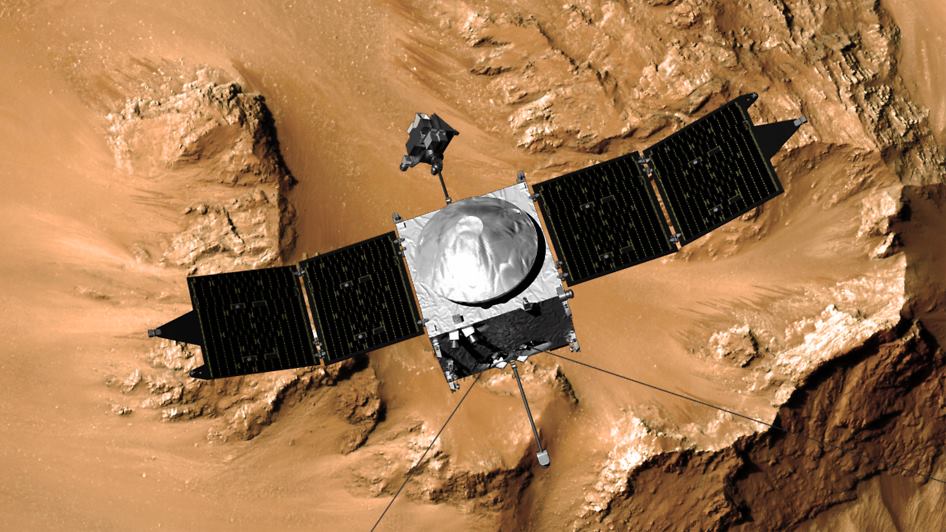
The STATIC instrument is giving new insights into how gases leave the atmosphere by determining the rate of atmospheric loss.
“STATIC primary objective is measuring the entire process of acceleration of ions at Mars and their escape,” said Jim McFadden, STATIC Instrument Lead, University of California at Berkeley.
It detected the “polar plume” of ions escaping from Mars just hours after being activated.
“The instrument hangs off the bottom of the spacecraft and has a ion and velocity analyzer.”
It measures the heating of charged gases from cold ionospheric ions to escape velocities as the spacecraft increases in altitude.
“The dominant species is O2+ at about 250 km. It decreases at higher altitudes as O2 increases to 300 km.”
“At higher altitude the ions are at higher energy and are energized to achieve escape velocity, greater than 10,000 times to a million times their initial velocity.”
The energized ions ultimately break free of the planet’s gravity as they move along a plume that extends behind Mars, said the team.
“The polar plume is one of the main processes for atmospheric loss at Mars, which is the main objective of the MAVEN mission,” said McFadden.
MAVEN achieved orbit around the Red Planet on Sept. 21, 2014, after successfully completing the crucial Mars Orbit Insertion (MOI) thruster braking maneuver following a 10-month interplanetary journey from Earth.
During the six-week-long commissioning phase, all the science instruments were activated and painstakingly checked out and calibrated, and instrument booms and caps were deployed.
Through a series of seven additional thruster firings, the orbit was gradually adjusted and lowered from its initial 35-hour highly elliptical capture orbit at a 75-degree inclination and a periapsis of 236 miles (380 km).
MAVEN is now in its final 4.6-hour elliptical science mapping orbit.
Over the course of its one-Earth-year primary mission, MAVEN will observe all of Mars’ latitudes from its elliptical orbit at altitudes ranging from a low point (periapsis) of about 150 km (93 miles) above the surface to an upper point (apoapsis) as high as about 6220 km (3800 miles).
The 5,400-pound MAVEN probe carries nine sensors in three instrument suites to study why and exactly when did Mars undergo the radical climatic transformation.
The Particles and Fields Package, provided by the University of California at Berkeley with support from CU/LASP and NASA’s Goddard Space Flight Center in Greenbelt, Md., contains six instruments to characterize the solar wind and the ionosphere of Mars. The Remote Sensing Package, built by CU/LASP, will determine global characteristics of the upper atmosphere and ionosphere. The Neutral Gas and Ion Mass Spectrometer, built by Goddard, will measure the composition of Mars’ upper atmosphere.
The primary mission includes five “deep-dip” campaigns, in which MAVEN’s periapsis, or lowest orbit altitude, will be lowered from 93 miles (150 kilometers) to about 77 miles (125 kilometers). This marks the lower boundary of the planet’s upper atmosphere.
These “deep-dip” measurements will provide information down to where the upper and lower atmospheres meet, giving scientists a full profile of the upper tier.
“MAVEN is operating at full technical capacity as intended at Mars as we planned from the outset. It will take a few months to get a complete picture at Mars and we are on track to accomplish that with a year as we wanted,” noted Jakosky at the briefing.
“We did this on schedule and significantly under our approved NASA budget five years ago.”
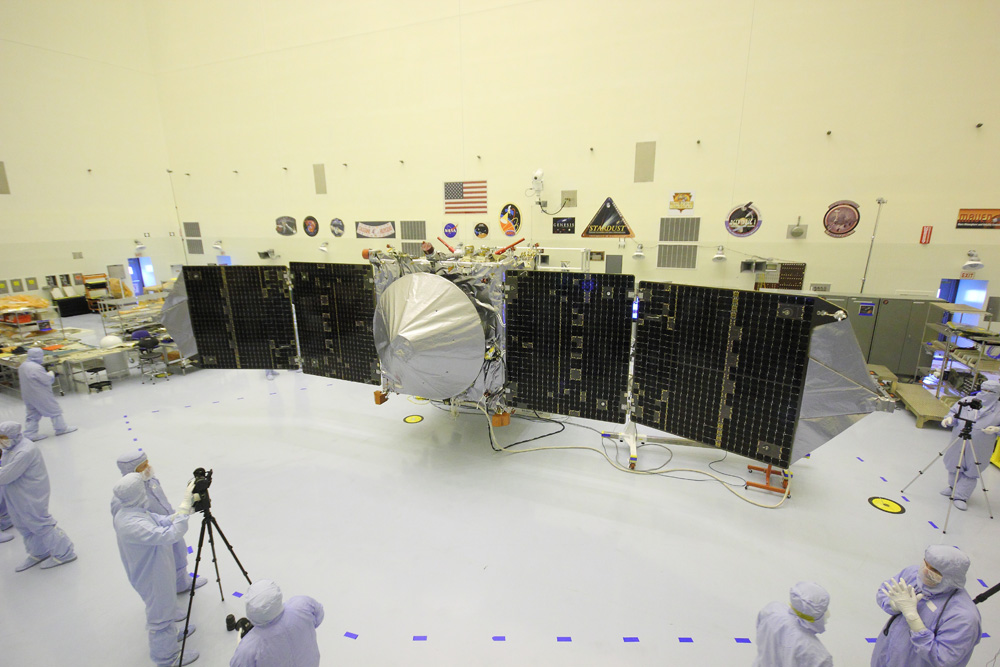
MAVEN thundered to space on Nov. 18, 2013, following a flawless blastoff from Cape Canaveral Air Force Station’s Space Launch Complex 41 atop a powerful United Launch Alliance Atlas V rocket.
MAVEN, along with India’s newly arrived and first-ever interplanetary probe the Mars Orbiter Mission (MOM), joins a record breaking armada of seven Earth spacecraft exploring the Red Planet.
Stay tuned here for continuing developments regarding Earth’s “Missions to Mars.”
Want to keep up-to-date with all things space? Be sure to “Like” AmericaSpace on Facebook and follow us on Twitter: @AmericaSpace
Missions » MAVEN » Missions » MOM »


